As part of its annual results statement in May each year, Singapore Airlines publishes its fleet development plan to investors, outlining the latest schedule showing which aircraft are set to leave and join the fleet during the year ahead.
This year, the mainline carrier’s passenger fleet will expand from 142 to 147 aircraft. Most of the new additions will be Boeing 787-10s, equipped with the 2018 Regional Business Class seats. Additionally, the carrier will receive its final passenger Airbus A350, the last brand new SIA aircraft to feature the 2013 Business Class seats.
Three more ex-SilkAir Boeing 737-800s will also leave the airline as their leases expire, joining the two already retired from the original set of nine that SIA integrated into its fleet in March 2021.
These will be replaced by two brand new Boeing 737-8 MAX aircraft, leaving only 11 more MAX jets to join the fleet from April 2025 onwards.
Unfortunately, there is still no sign of any Boeing 777-9 additions – the type SIA urgently needs in order to retire its ageing Boeing 777-300ERs and finally launch a suite of new cabin products, which were initially set to debut in 2021.
SIA’s 777-9s are still officially scheduled to join the fleet in 2025, but other launch customers like Emirates and Lufthansa are already suggesting a 2026 introduction at the earliest.
SIA Fleet movements
Here’s how SIA’s latest fleet development plan looks for the mainline carrier over the 12 months from 31st March 2024 to 31st March 2025.
We’re only focused on passenger aircraft, and so have excluded the carrier’s seven cargo jets.
| Aircraft Type | SIA Passenger Fleet Totals | |||
| 31 Mar ’24 | Leaving | Joining | 31 Mar ’25 | |
| A350-900 MH | 24 | 24 | ||
| A350-900 LH | 32 | + 2 | 34 | |
| A350-900 ULR | 7 | 7 | ||
| A380-800 | 12 | 12 | ||
| 737-800 | 7 | – 3 | 4 | |
| 737-8 MAX | 16 | + 2 | 18 | |
| 777-300ER | 22 | 22 | ||
| 787-10 | 22 | + 4 | 26 | |
| All Types | 142 | – 3 | + 8 | 147 |
Firstly, it’s important to note that since the baseline date is March 31, 2024, one of these fleet movements has already occurred at the time of writing:
- 1 of the 2 Airbus A350 Long Haul additions listed in the table (9V-SJH) was delivered on 19th April 2024 and entered service on 26th April 2024. Consequently, only 1 more of these aircraft is set to join the fleet this financial year (9V-SJI, expected in Q3 2024).
The Boeing 737-800 fleet is reducing
As we reported in March this year, Singapore Airlines is set to return three more of its ex-SilkAir Boeing 737-800 aircraft to lessors during this financial year, something the airline could not confirm to us at the time, but has since now stated in its annual results update.
These ex-SilkAir jets have older cabin products, including a fairly lacklustre recliner Business Class recliner seat, and so news of their demise is roundly welcomed among our readers.

That’s especially true while the type is still used on some longer flights, like 5-hour Singapore – Kathmandu sectors.
SIA promised fleet-wide flat-bed Business Class including on its narrow-body aircraft from early 2020, yet here we are over four years later with the airline still clinging on to these 737-800s.
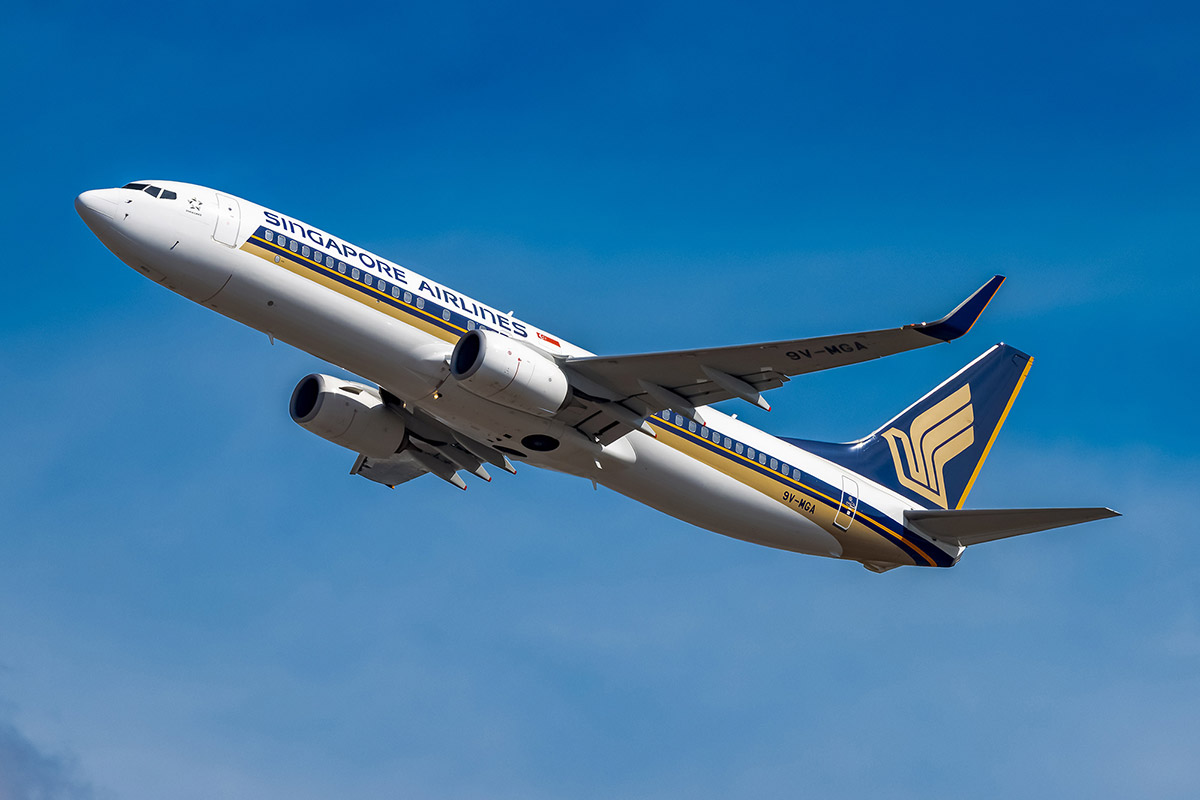
In fairness, the situation is not completely SIA’s fault – in fact the airline never intended to operate these planes in the first place.
SilkAir’s Boeing 737-800s were originally intended for low-cost subsidiary Scoot, while SIA planned to acquire only the regional subsidiary’s Boeing 737-8 MAX jets. These MAX aircraft would be refitted with brand new flat-bed Business Class seats, tip-to-tail in-flight entertainment systems, and Wi-Fi connectivity.
The plan was sadly derailed, when two fatal crashes of the Boeing 737 MAX aircraft in late 2018 and early 2019 caused a global grounding of the aircraft type SIA had pinned its hopes to, as the carrier’s future full-service narrow-body model.
The result? SIA was forced to keep these older Boeing 737-800s flying in its full-service division for a lot longer than anticipated.
With light now at the end of the tunnel as far as Boeing 737-800s leaving the fleet is concerned, here’s how SIA’s use of the type is set to dwindle from September 2024 onwards.
While advance schedules remain somewhat provisional, especially when it comes to actual aircraft allocation, by May 2026 Singapore Airlines is only planning two flights per day using its remaining Boeing 737-800 aircraft; a morning Penang flight and an afternoon Kuala Lumpur flight.
This hopefully paves the way for the full wind-down of this fleet even sooner than expected, but in any event that will happen by the end of 2025 anyway, once the final aircraft heads back to its lessor.
The final Airbus A350 delivery is imminent
As we noted above, only two more Airbus A350 Long Haul aircraft are arriving in the SIA fleet this year, and one of those (9V-SJH) has already been delivered and is now in service with the carrier.
Singapore Airlines will therefore take delivery of one more Airbus A350 Long Haul this year, 9V-SJI, which we understand is planned for sometime in Q3 2024.
9V-SJI will be the final passenger Airbus A350 delivered to the airline, with no further A350s on order.

This will therefore also represent the last new aircraft delivered to SIA with the 2013 long-haul Business Class cabin product installed.
Future long-haul aircraft deliveries to the carrier will be Boeing 777-9s, with all-new First Class, Business Class, Premium Economy and Economy Class seats installed.
The carrier’s remaining Airbus A350 deliveries after 9V-SJI will be seven of the A350F cargo jets, which will replace SIA’s ageing Boeing 747-400 freighters from late 2025.
The aircraft falls in size approximately halfway between the Airbus A350-900 and the Airbus A350-1000. It will have the capability to transport 111 tonnes of freight over a distance of 8,700 km, very similar to the Boeing 747-400F, but with 40% less fuel burn.
Ultimately SIA will operate 65 passenger A350s (34 Long Haul, 24 Medium Haul and 7 ULR), plus 7 A350 freighters, making it the second largest operator of the type, after Qatar Airways.
One more 777-300ER retained
In last year’s fleet update, Singapore Airlines said it intended to reduce its 23-strong Boeing 777-300ER fleet to 21 aircraft by March 2024, however 22 of the type have been retained, all of which are now back in service.
In November 2022, Singapore Airlines CEO Goh Choon Phong confirmed that the airline would be extending the operational lifespan of its Boeing 777-300ERs to compensate for the fleet shortfall resulting from ongoing Boeing 777-9 delivery delays.
Because of a delay in the 777-9s, we do have to look at extending the use of some of the aircraft that we have, particularly the older 777-300ERs.
Goh Choon Phong, CEO, Singapore Airlines
17th May 2023
The decision to retain an additional 22nd aircraft in this fleet compared to the original plan appears to be part of this solution.
Aside from the confirmed removal of 9V-SWA, -SWD, SWE and -SWF from the fleet already, Mainly Miles understands that 9V-SWN will also not be returning to service.

SIA’s oldest operating 777-300ER, 9V-SWB, is approaching 18 years of age. The airline typically does not keep aircraft in its fleet beyond around 15 years.
Boeing 787-10s make up the bulk of new deliveries
As you can see from the planned new deliveries table above, the bulk of new aircraft joining the SIA fleet this year are the carrier’s highest capacity aircraft type after the A380s – 337-seat Boeing 787-10s.

23 of these were supposed to be in the fleet by 31st March 2024, but further issues at manufacturer Boeing have once again slowed new deliveries, and SIA only received 7 out of the 8 it was supposed to during the last financial year.
Boeing’s total 2024 calendar year deliveries for the 787 so far only total 19 at the time of writing (a far cry from the 52 delivered between 1st January and 23rd May 2019).
Both SIA and Scoot already suffered a long delay in Boeing 787 deliveries over regulatory issues in recent years, with the FAA halting the programme at least twice, causing a three-year gap in new aircraft arrivals for both carriers.
Hopefully the forecast delivery of 4 Boeing 787-10 aircraft for the current financial year will be realised, since this aircraft type now serves as the primary means for the airline to achieve growth in the short-term.
What it means for Business Class seats
Here’s the bit most of our readers are interested in – what do the fleet changes mean for Singapore Airlines Business Class seats?
The following table shows how many of each Business Class seat type was in the operating fleet as of 31st March 2024 (already slightly out of date), and what that represents as a proportion of all SIA Business Class seats installed, plus how it looks at the end of the current financial year on 31st March 2025.
| Seat Type | 31 Mar 2024 | 31 Mar 2025 | ||
| Total | As % | Total | As % | |
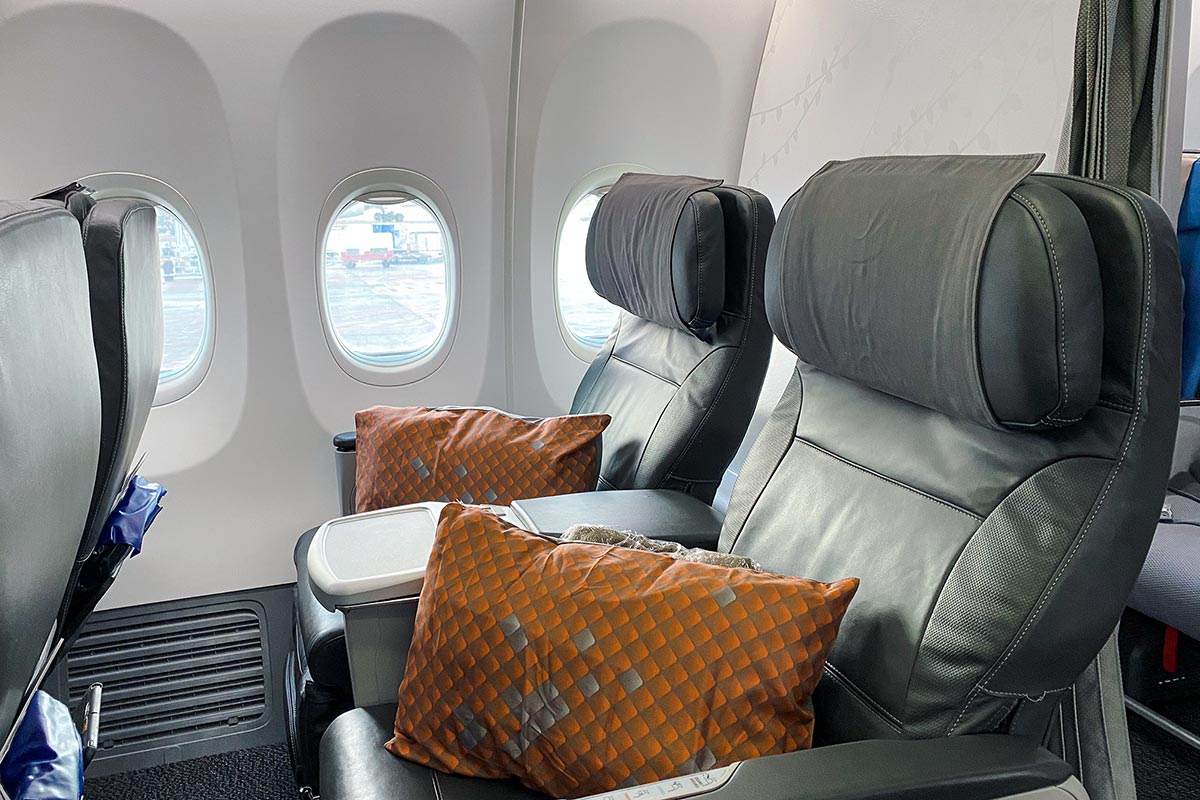 738 RJ 738 RJ |
84 | 1.4% | 48 | 0.8% |
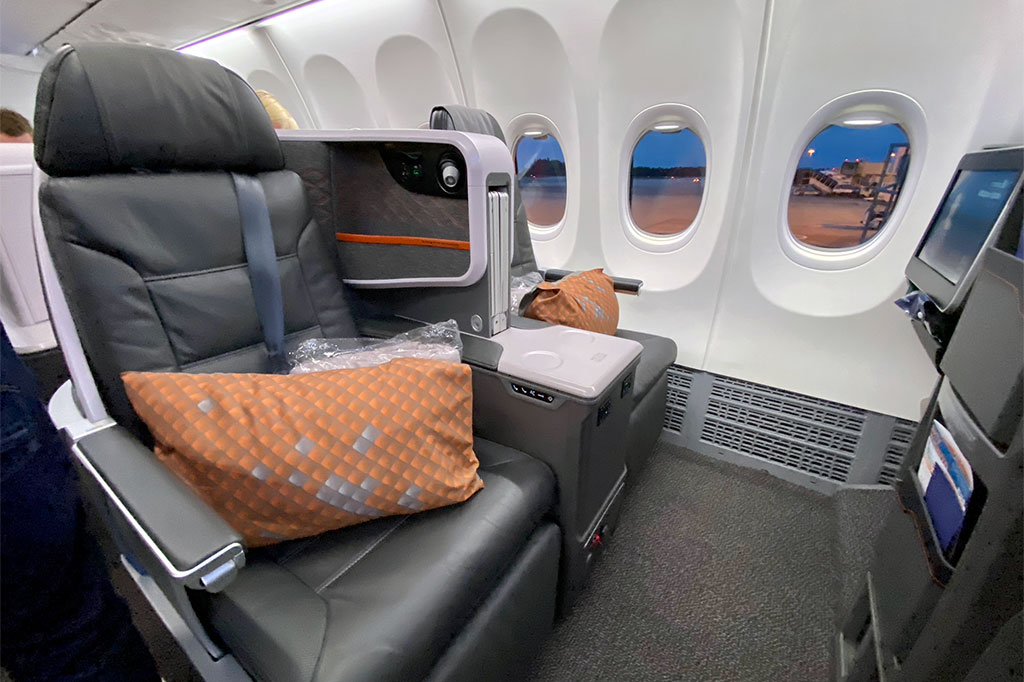 MAX RJ MAX RJ |
160 | 2.8% | 180 | 3.0% |
 2013 J 2013 J |
2,869 | 49.5% | 2,953 | 49.1% |
 2017 J 2017 J |
936 | 16.1% | 936 | 15.6% |
 2018 RJ 2018 RJ |
1,752 | 30.2% | 1,896 | 31.5% |
| Total | 5,801 | 6,013 | ||
The 2018 RJ product is making the greatest headway, thanks to 4 planned Boeing 787-10 deliveries between now and the end of March 2025, rising to 31.5% of installed Business Class seats across the fleet.
The oldest long-haul Business Class, 2013 J, will contract to represent slightly to less than half of those installed fleet-wide.
After peaking at 2,953 seats installed across the fleet, this decade-old seat design will decline both in percentage and actual numbers in the future, as Boeing 777-9s are introduced and older Airbus A350 Long Haul aircraft are inevitably retrofitted with the latest long-haul Business Class seats.
Additional 2018 RJ seats will join the fleet in subsequent years too, with 5 more Boeing 787-10s still on the order book from April 2025 onwards, so we wouldn’t be surprised to see it represent well over a third of Business Class seats installed fleet-wide in the not too distant future.

What it means for First Class seats
The following table shows how many of each First Class seat was in the operating fleet as of 31st March 2024, and what that represents as a proportion of all SIA First Class seats installed, plus how it looks at the end of the current financial year on 31st March 2025.
| Seat Type | 31 Mar 2024 | 31 Mar 2025 | ||
| Total | As % | Total | As % | |
 2013 F 2013 F |
88 | 55.0% | 88 | 55.0% |
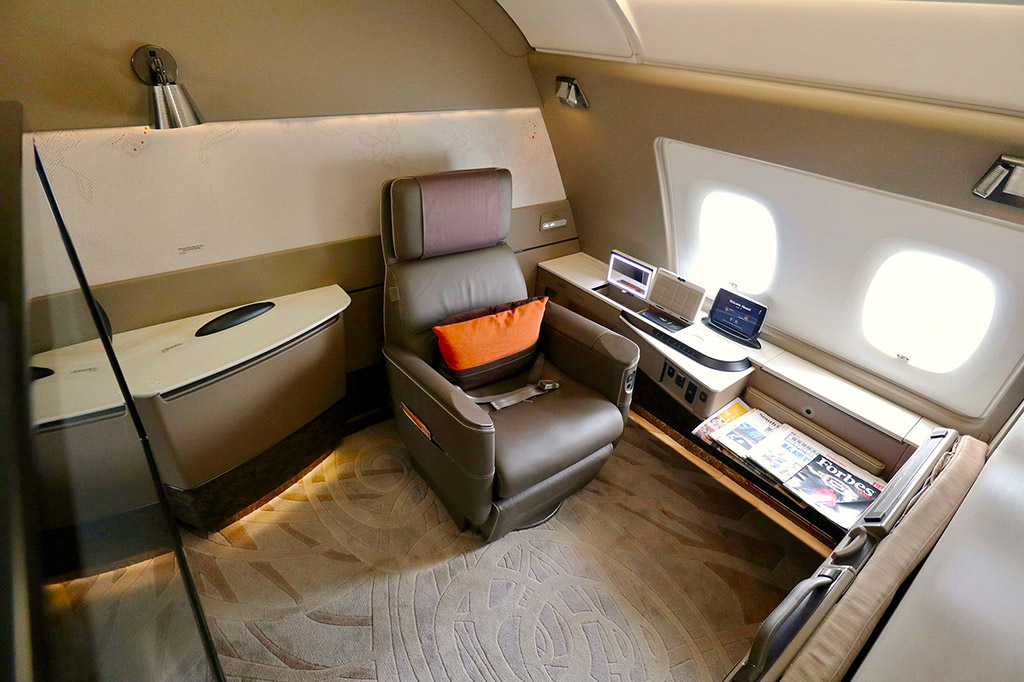 2017 R 2017 R |
72 | 45.0% | 72 | 45.0% |
| Total | 160 | 160 | ||
As you can see, there is no change to the balance between 2013 First Class seats and 2017 Suites seats across the fleet over the next year, with the number of Boeing 777-300ERs and Airbus A380s remaining constant at 22 and 12 respectively.
As an aside, 160 First Class and Suites seats fleet-wide remains the lowest SIA has offered in decades.
Prior to the pandemic, there were 334 First Class and Suites seats in the fleet. Back in 2010, there were 670!
Hopefully the upcoming fleet of 31 Boeing 777-9s will each have at least 4 First Class seats (though we’re really hoping for 6 or even 8), to help boost this cabin’s presence once again on the network.

With a “quantum leap” promised in this cabin, the new version should offer enclosed suites, or suite-like seat products, with full privacy. We’ve also got our fingers crossed for a double bed option for couples, and companion dining.
When are the 777-9s arriving?
Singapore Airlines still expects to receive its first Boeing 777-9 in 2025, a timeframe CEO Goh Choon Phong recently reiterated.
“At this point in time, based on our understanding, we are expecting the Boeing 777-9s to be delivered next year”.
Goh Choon Phong, CEO, Singapore Airlines
16th May 2024
Regional rival Cathay Pacific is also bullish about delivery prospects for the type, recently stating in its annual results that it should have two Boeing 777-9s in its fleet by the end of 2025.
Step away from Asia though, and the sentiment isn’t quite so rosy.
Earlier this year Emirates, the largest Boeing 777-9 customer, flagged an October 2025 delivery for its first Boeing 777-9, following an expectation of formal FAA Type Inspection Authorisation (TIA) in February 2024.
The aircraft has still not achieved TIA at the time of writing, in mid-May 2024.
Clark recently told reporters “Every day is a different day at Boeing. It could be the back end of next year, but more likely early 2026”.
Even more recently, Lufthansa’s CEO Jens Ritter said delays to the Boeing 777-9s certification process mean the Star Alliance carrier does not expect to introduce its first aircraft to service until the summer 2026 season “at the earliest”, which means 29th March 2026 or later.
The long wait for SIA’s new cabin products may turn out to be even longer than its management currently expects.
Scoot Fleet movements
For those of you interested in the fleet development of SIA’s low-cost carrier Scoot, here’s how the latest plan looks for the 12 months from 31st March 2024 to 31st March 2025.
| Aircraft Type | Scoot Passenger Fleet Totals | |||
| 31 Mar ’24 | Leaving | Joining | 31 Mar ’25 | |
| A320ceo | 15 | – 4 | 11 | |
| A320neo | 6 | + 1 | 7 | |
| A321neo | 9 | 9 | ||
| 787-8 | 11 | + 2 | 13 | |
| 787-9 | 10 | 10 | ||
| E190-E2 | — | + 5 | 5 | |
| All Types | 51 | – 4 | + 8 | 55 |
Again since the baseline date for this fleet plan (31st March 2024) is already behind us, it’s already a little out of date, as follows:
- 3 of Scoot’s 15 Airbus A320ceos (9V-TRO, -TRQ and -TRR) have already left service and been flown to Kuala Lumpur for end of lease preparations. That leaves only one more A320ceo to exit the fleet for the remainder of this financial year.
- 2 of Scoot’s Embraer E190-E2 regional jets were delivered last month (9V-THA on 15th April 2024 and 9V-THB on 29th April 2024). Both aircraft have entered passenger service, on 7th May 2024 and 9th May 2024 respectively.
The additional 3 E190-E2s will actually arrive between September and December 2024, according to the airline.

Scoot has 9 E190-E2 aircraft on order in total, which means the final 4 deliveries lie outside this analysis, however we know from the airline’s recent statements that the all 9 are due to be in service by the end of next year, meaning those final 4 should be delivered between April and December 2025.
These aircraft feature a smaller 2-2 cabin configuration – great for couples with no dreaded ‘middle seat’, and currently operate on four routes – Krabi, Hat Yai, Koh Samui and Miri. Kuantan and Sibu will follow from June 2024.
Other Scoot deliveries for this financial year between now and 31st March 2025 comprise a single Airbus A320neo and two Boeing 787-8s.
That will bring the low-cost carrier’s total Boeing 787 fleet to 23, with just 1 more Boeing 787-9 then remaining for delivery after that.
From April 2025 onwards, Scoot also will also have a further 11 A320neo and 7 A321neo jets on order, for delivery in the years ahead.

Summary
Singapore Airlines is growing its passenger fleet from 142 to 147 aircraft by March 2025, and it’s the Boeing 787-10s making up the lion’s share of new deliveries.
This will see more of the 2018 Regional Business Class seats in the fleet, though the 2013 Long Haul Business Class remains dominant, with the final Airbus A350 Long Haul delivery in the next few months, plus one more Boeing 777-300ER retained compared to original plans.
Thankfully we now have confirmation that the unpopular Boeing 737-800 fleet is indeed dwindling from 7 to 4 aircraft this year, removing more ex-SilkAir recliner Business Class seats from the fleet, all of which will be gone by the end of next year in any event.
Aside from that there will be no major changes in the cabin product mix until the arrival of the Boeing 777-9, which SIA still expects during 2025, despite other launch customers now being less optimistic, as the certification process appears to have stalled.
(Cover Photo: Stelia Aerospace)
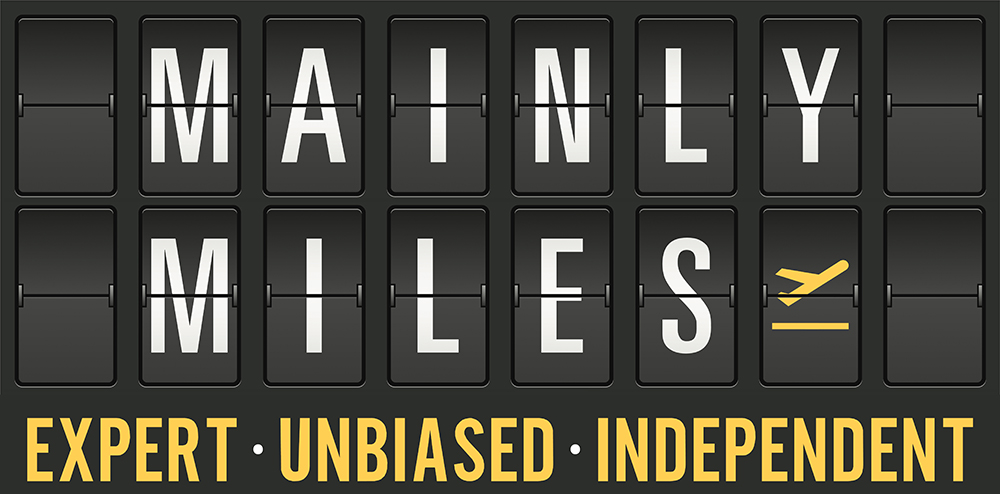



The regional biz class seats are very uncomfortable.
Agreed. The wings are useless and make an already narrow seat “feel” even tighter.
Not sure why they cant just have ‘business class’ and premium econ on the longhaul legs. Their use of aircraft for LH and MH is inconsistent. How can beijing be a MH flight and KL be LH.
Hi,
In the second section you mention the last A350 is scheduled to arrive in Q3 2024, but in the fourth section you mention its due in Q2 2024. Which would be the correct delivery timeframe?
Thanks
Thanks, its Q3. Corrected.